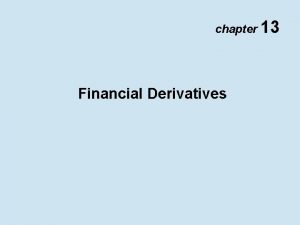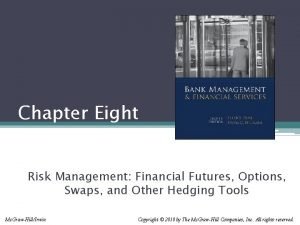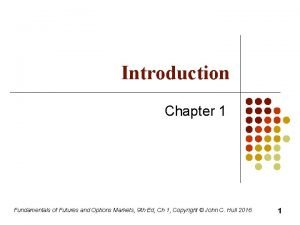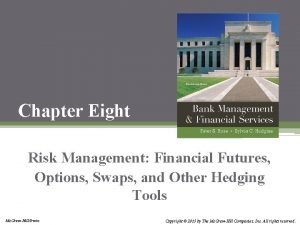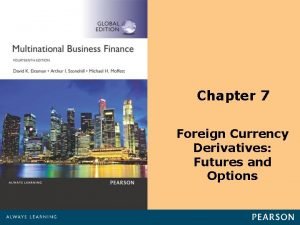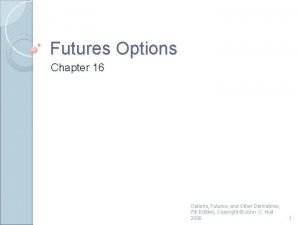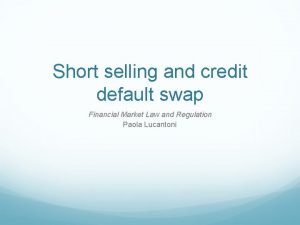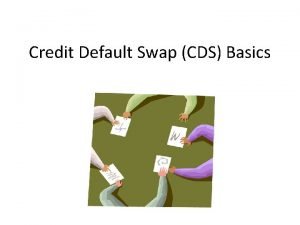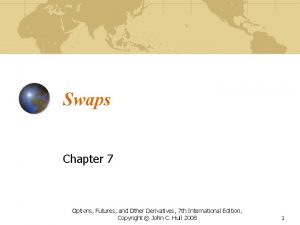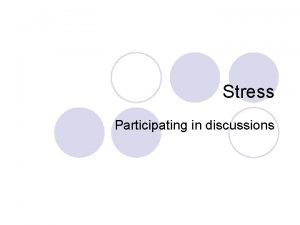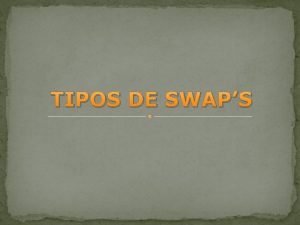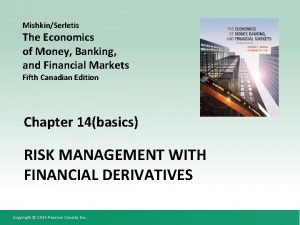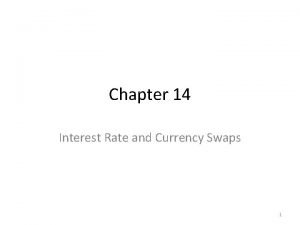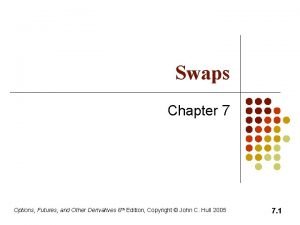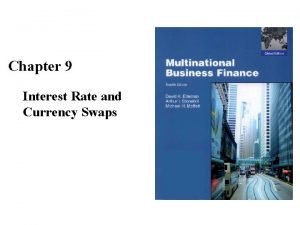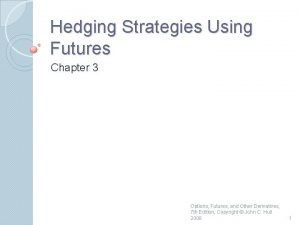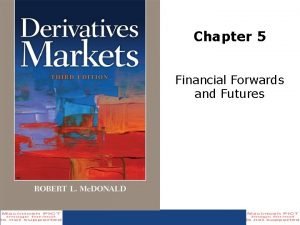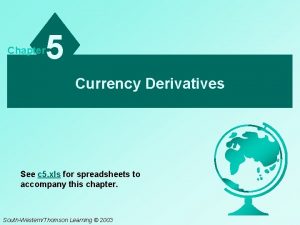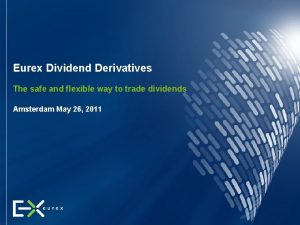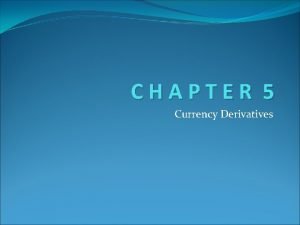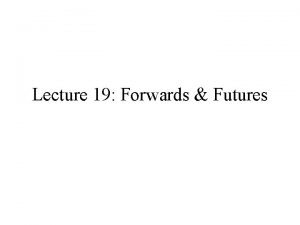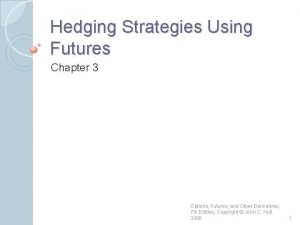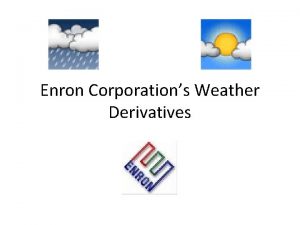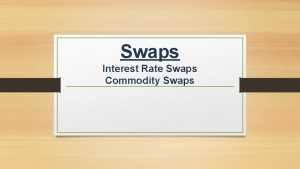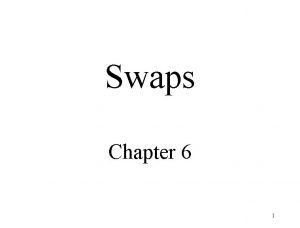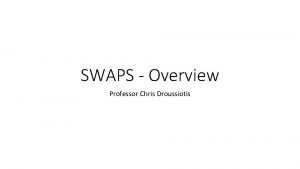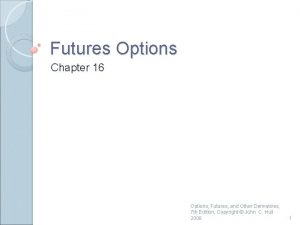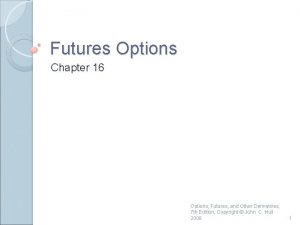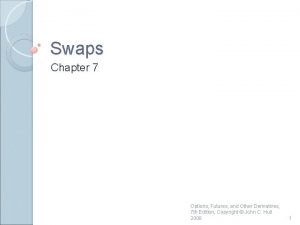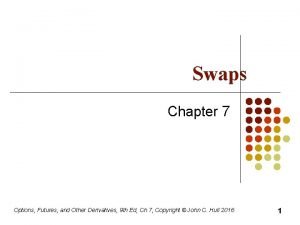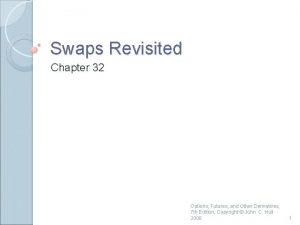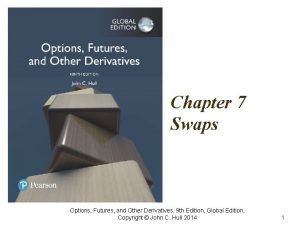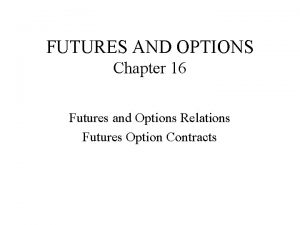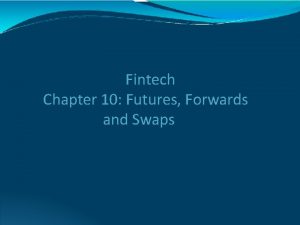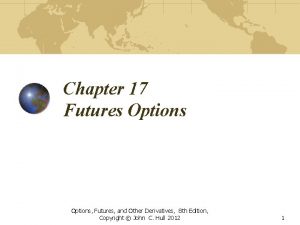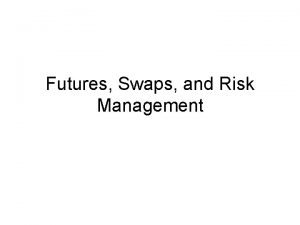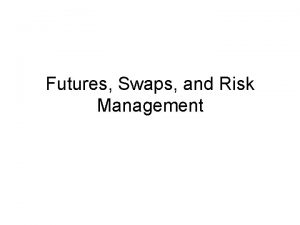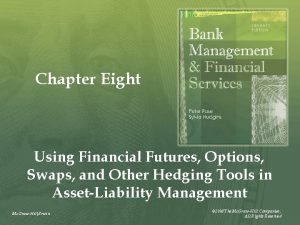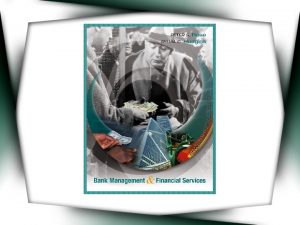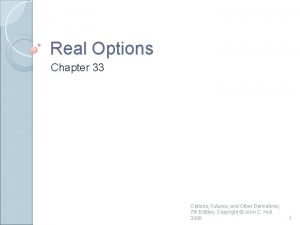1 Swaps Chapter 5 Options Futures and Other










































- Slides: 42

1 Swaps (互换) Chapter 5 Options, Futures, and Other Derivatives, 4 th edition © 2000 by John C. Hull Tang Yincai, Shanghai Normal University

2 Nature of Swaps • A swap is an agreement to exchange cash flows (现金流) at specified future times according to certain specified rules Options, Futures, and Other Derivatives, 4 th edition © 2000 by John C. Hull Tang Yincai, Shanghai Normal University

3 Terminology • LIBOR the London Inter. Bank Offer Rate It is the rate of interest offered by banks on deposits from other banks in Eurocurrency markets Options, Futures, and Other Derivatives, 4 th edition © 2000 by John C. Hull Tang Yincai, Shanghai Normal University

4 An Example of a “Plain Vanilla” Interest Rate Swap(大众型利率互换) • An agreement by “Company B” to RECEIVE 6 -month LIBOR and PAY a fixed rate of 5% pa every 6 months for 3 years on a notional principal of $100 million • Next slide illustrates cash flows, where POSITIVE flows are revenues (inflows) and NEGATIVE flows are expenses (outflows) Options, Futures, and Other Derivatives, 4 th edition © 2000 by John C. Hull Tang Yincai, Shanghai Normal University

Cash Flows to Company B (See Table 5. 1, page 123) -----Millions of Dollars----LIBOR FLOATING FIXED Net Date Rate Cash Flow Mar. 1, 1999 4. 2% Sept. 1, 1999 4. 8% +2. 10 – 2. 50 – 0. 40 Mar. 1, 2000 5. 3% +2. 40 – 2. 50 – 0. 10 Sept. 1, 2000 5. 5% +2. 65 – 2. 50 +0. 15 Mar. 1, 2001 5. 6% +2. 75 – 2. 50 +0. 25 Sept. 1, 2001 5. 9% +2. 80 – 2. 50 +0. 30 Mar. 1, 2002 6. 4% +2. 95 – 2. 50 +0. 45 Options, Futures, and Other Derivatives, 4 th edition © 2000 by John C. Hull Tang Yincai, Shanghai Normal University 5

6 More on Table 5. 1 • The floating-rate payments are calculated using the six-month LIBOR rate prevailing six month before the payment date • The principle is only used for the calculation of interest payments. However, the principle itself is not exchanged—Meaning for “Notional principle” • The swap can be regarded as the exchange of a fixed-rate bond for a float-rate bond. Company B (A) is long (short) a floating-rate bond and short (long) a fixed-rate bond. Options, Futures, and Other Derivatives, 4 th edition © 2000 by John C. Hull Tang Yincai, Shanghai Normal University

7 Typical Uses of an Interest Rate Swap • Converting a liability from a • Converting an investment from a – FIXED rate liability to a FLOATING rate liability – FIXED rate investment to a FLOATING rate investment – FLOATING rate liability to a FIXED rate liability – FLOATING rate investment to a FIXED rate investment Options, Futures, and Other Derivatives, 4 th edition © 2000 by John C. Hull Tang Yincai, Shanghai Normal University

Transforming a Floating-rate Loan to a Fixed-rate • Consider a 3 -year swap initialized on March 1, 2000 where Company B agrees to pay Company A 5%pa on $100 million Company A agrees to pay Company B 6 -mth LIBOR on $100 million • Suppose Company B has arranged to borrow $100 million LIBOR + 80 bp Company A 5. 2% 5% LIBOR Company B LIBOR+0. 8% Note: 1 basis point (bp) = one-hundredth of 1% Options, Futures, and Other Derivatives, 4 th edition © 2000 by John C. Hull Tang Yincai, Shanghai Normal University 8

9 Transforming a Floating-rate Loan to a Fixed-rate (continued) • After Company B has entered into the swap, they have 3 sets of cash flows 1. Pays LIBOR plus 0. 8% to outside lenders 2. Receives LIBOR from Company A in the swap 3. Pays 5% to Company A in the Swap • In essence, B has transformed its variable rate borrowing at LIBOR + 80 bp to a fixed rate of 5. 8% Options, Futures, and Other Derivatives, 4 th edition © 2000 by John C. Hull Tang Yincai, Shanghai Normal University

10 A and B Transform a Liability (Figure 5. 2, page 125) 5% 5. 2% A B LIBOR+0. 8% LIBOR Options, Futures, and Other Derivatives, 4 th edition © 2000 by John C. Hull Tang Yincai, Shanghai Normal University

11 Financial Institution is Involved (Figure 5. 4, page 126) 4. 985% 5. 015% 5. 2% A F. I. B LIBOR+0. 8% LIBOR “Plain vanilla” fixed-for-float swaps on US interest rates are usually structured so that the financial institutions earns 3 to 4 basis points on a pair of offsetting transactions Options, Futures, and Other Derivatives, 4 th edition © 2000 by John C. Hull Tang Yincai, Shanghai Normal University

12 A and B Transform an Asset (Figure 5. 3, page 125) 5% 4. 7% A B LIBOR-0. 25% LIBOR Options, Futures, and Other Derivatives, 4 th edition © 2000 by John C. Hull Tang Yincai, Shanghai Normal University

13 Financial Institution is Involved (See Figure 5. 5, page 126) 4. 985% 5. 015% 4. 7% A F. I. LIBOR-0. 25% LIBOR B LIBOR Options, Futures, and Other Derivatives, 4 th edition © 2000 by John C. Hull Tang Yincai, Shanghai Normal University

14 The Comparative Advantage Argument (Table 5. 4, page 129) • Company A wants to borrow floating • Company B wants to borrow fixed Floating Company A 10. 00% 6 -month LIBOR + 0. 30% Company B 11. 20% 6 -month LIBOR + 1. 00% Options, Futures, and Other Derivatives, 4 th edition © 2000 by John C. Hull Tang Yincai, Shanghai Normal University

15 The Comparative Advantage (continued) • One possible swap is 10% • Company A 9. 95% LIBOR Company A has 3 sets of cash flows 1. Pays 10%pa to outside lenders 2. Receives 9. 95%pa from B 3. Pays LIBOR to B Company B LIBOR + 1% Pays LIBOR + 0. 05% a 25 bp gain • Company B has 3 sets of cash flows 1. Pays LIBOR + 1. 00%pa to outside lenders 2. Receives LIBOR from A 3. Pays 9. 95% to A Pays 10. 95%pa a 25 bp gain Options, Futures, and Other Derivatives, 4 th edition © 2000 by John C. Hull Tang Yincai, Shanghai Normal University

16 The Swap (Figure 5. 6, page 130) 9. 95% 10% A B LIBOR+1% LIBOR Options, Futures, and Other Derivatives, 4 th edition © 2000 by John C. Hull Tang Yincai, Shanghai Normal University

17 The Swap when a Financial Institution is Involved (Figure 5. 7, page 130) 9. 93% 9. 97% 10% A F. I. LIBOR B LIBOR+1% LIBOR Options, Futures, and Other Derivatives, 4 th edition © 2000 by John C. Hull Tang Yincai, Shanghai Normal University

18 Total Gain from an Interest Rate Swap • The total gain from an interest rate swap is always |a-b| where • a is the difference between the interest rates in the fixed-rate market for the two parties, and • b is the difference between the interest rates in the floating-rate market for the two parties • In this example a=1. 20% and b=0. 70% Options, Futures, and Other Derivatives, 4 th edition © 2000 by John C. Hull Tang Yincai, Shanghai Normal University

19 Criticism of the Comparative Advantage Argument • The 10. 0% and 11. 2% rates available to A and B in fixed rate markets are 5 -year rates • The LIBOR+0. 3% and LIBOR+1% rates available in the floating rate market are six-month rates • B’s fixed rate depends on the spread above LIBOR it borrows at in the future Options, Futures, and Other Derivatives, 4 th edition © 2000 by John C. Hull Tang Yincai, Shanghai Normal University

20 Valuation of an Interest Rate Swap • Interest rate swaps can be valued as the difference between --the value of a fixed-rate bond & --the value of a floating-rate bond • Alternatively, they can be valued as a portfolio of forward rate agreements (FRAs) Options, Futures, and Other Derivatives, 4 th edition © 2000 by John C. Hull Tang Yincai, Shanghai Normal University

21 Valuation of an Interest Rate Swap as a Package of Bonds • The fixed rate bond is valued in the usual way (page 132) • The floating rate bond is valued by noting that it is worth par immediately after the next payment date (page 132) Options, Futures, and Other Derivatives, 4 th edition © 2000 by John C. Hull Tang Yincai, Shanghai Normal University

22 Valuation of an Interest Rate Swap as a Package of Bonds (continued) • • Define Vswap: value of the swap to the financial institution Bfix: value of the fixed-rate bond underlying the swap Bfl: value of the floating-rate bond underlying the swap L: notional principal in a swap agreement ti: time when the ith payments are exchanged ri: LIBOR zero rate for a maturity ti Then, Vswap = Bfix - Bfl and if k is the fixed-rate coupon and k* is the floating Options, Futures, and Other Derivatives, 4 th edition © 2000 by John C. Hull Tang Yincai, Shanghai Normal University

Example of an Interest Rate Swap Valued as a Package of Bonds 23 Suppose, that you agreed to pay 6 -month LIBOR and receive 8% pa (with semiannual compounding) on a notional amount of $100 million. The swap has a remaining life of 15 months and the next payment is due in 3 months. The relevant rates for continuous compounding over 3, 9, and 15 months are 10. 0%, 10. 5%, and 11. 0%, respectively. The six-month LIBOR rate at the last payment was 10. 2% (with semi-annual compounding). In this case k = $4 million and k* = $5. 1 million, so that Bfix= 4 e-0. 25 x 0. 10 + 4 e-0. 75 x 0. 105 + 104 e-1. 25 x 0. 11 = $ 98. 24 million Bfl = 5. 1 e-0. 25 x 0. 10 + 100 e-0. 25 x 0. 10 = $102. 51 million Hence, Vswap = 98. 24 - 102. 51 = -$4. 27 million Options, Futures, and Other Derivatives, 4 th edition © 2000 by John C. Hull Tang Yincai, Shanghai Normal University

24 Valuation in Terms of FRAs • Each exchange of payments in an interest rate swap is an FRA • The FRAs can be valued on the assumption that today’s forward rates are realized (See section 4. 6, page 97) Options, Futures, and Other Derivatives, 4 th edition © 2000 by John C. Hull Tang Yincai, Shanghai Normal University

25 Valuation of an Interest Rate Swap as a Package of FRAs A simple three step process 1. Calculate each of the forward rates for each of the LIBOR rates that will determine swap cash flows 2. Calculate swap cash flows on the assumption that the LIBOR rates will equal the forward rates 3. Set the swap rates equal to the present value of these cash flows Options, Futures, and Other Derivatives, 4 th edition © 2000 by John C. Hull Tang Yincai, Shanghai Normal University

26 Example of an Interest Rate Swap Valued as a Package of FRAs Same problem as before. The cash flows for the payment in 3 months have already been set. A rate of 8% will be exchanged for a rate of 10. 2%. The NPV of this transaction is 0. 5 * 100 * (0. 08 - 0. 102)e-0. 1*0. 25 = -1. 07 To figure out the NPV of the remaining two payments, we first need to calculate the forward rates corresponding to 9 and 15 months or 10. 75% with continuous compounding which corresponds to 11. 044% with semi-annual compounding. The value of the 9 month FRA is 0. 5 * 100 * (0. 08 - 0. 11044)e-0. 105*0. 75 = -1. 41 Options, Futures, and Other Derivatives, 4 th edition © 2000 by John C. Hull Tang Yincai, Shanghai Normal University

27 Example Swap as Valued as FRAs (continued) The 15 month forward rate is or 11. 75% with continuous compounding which corresponds to 12. 102% with semi-annual compounding. The value of the 15 month FRA is 0. 5 * 100 * (0. 08 - 0. 12102)e-0. 11*1. 25 = -1. 79 Hence, the total value of the swap is -1. 07 - 1. 41 - 1. 79 = -4. 27 Options, Futures, and Other Derivatives, 4 th edition © 2000 by John C. Hull Tang Yincai, Shanghai Normal University

28 An Example of a Currency Swap An agreement to -- pay 11% on a sterling principal of £ 10, 000 & -- receive 8% on a US$ principal of $15, 000 -- every year for 5 years Options, Futures, and Other Derivatives, 4 th edition © 2000 by John C. Hull Tang Yincai, Shanghai Normal University

29 Exchange of Principal • In an interest rate swap the principal is not exchanged • In a currency swap the principal is exchanged at -- the beginning & -- the end of the swap Options, Futures, and Other Derivatives, 4 th edition © 2000 by John C. Hull Tang Yincai, Shanghai Normal University

30 The Cash Flows (Table 5. 5, page 137) Dollars Pounds $ £ Years ------millions-----0 – 15. 00 +10. 00 +1. 20 – 1. 10 1 2 +1. 20 – 1. 10 3 +1. 20 – 1. 10 4 +1. 20 – 1. 10 5 +16. 20 -11. 10 Options, Futures, and Other Derivatives, 4 th edition © 2000 by John C. Hull Tang Yincai, Shanghai Normal University

31 Typical Uses of a Currency Swap • Conversion from a liability in one currency to a liability in another currency • Conversion from an investment in one currency to an investment in another currency Options, Futures, and Other Derivatives, 4 th edition © 2000 by John C. Hull Tang Yincai, Shanghai Normal University

32 Comparative Advantage Arguments for Currency Swaps (Table 5. 6, pages 137 -139) • Company A wants to borrow AUD • Company B wants to borrow USD Company A AUD 5. 0% 12. 6% Company B 7. 0% 13. 0% Options, Futures, and Other Derivatives, 4 th edition © 2000 by John C. Hull Tang Yincai, Shanghai Normal University

33 Valuation of Currency Swaps • Like interest rate swaps, currency swaps can be valued either as the -- difference between 2 bonds or as a -- portfolio of forward contracts Options, Futures, and Other Derivatives, 4 th edition © 2000 by John C. Hull Tang Yincai, Shanghai Normal University

34 Example for a Currency Swap • Suppose that the term structure of interest rates is flat in both US and Japan. Further suppose the interest rate is 9% pa in the US and 4% pa in Japan. Your company has entered into a three-year swap where it receives 5% pa in yen on 1, 200 million yen and pays 8% pa on $10 million. The current exchange rate is 110 yen = $1. Evaluate the swap under the assumption that payments are made just once per year. Options, Futures, and Other Derivatives, 4 th edition © 2000 by John C. Hull Tang Yincai, Shanghai Normal University

35 Example Valued as Bonds Here we have a domestic and a foreign bond BD = 0. 8 e-0. 09 x 1 + 0. 8 e-0. 09 x 2 + 10. 8 e-0. 09 x 3 = $ 9. 644 million BF = 60 e-0. 04 x 1 + 60 e-0. 04 x 2 + 1260 e-0. 04 x 3 = ¥ 1, 230. 55 million Thus, the value of the swap is Vswap= S 0 BF -BD Options, Futures, and Other Derivatives, 4 th edition © 2000 by John C. Hull Tang Yincai, Shanghai Normal University

36 Example Valued as FRAs The current spot rate is 110 yen per dollar or 0. 009091 dollars per yen. Because the interest rate differential is 5% the one, two, and three year exchange rates are (from eq (3. 13)) 0. 009091 e 0. 05 x 1 = 0. 0096 0. 009091 e 0. 05 x 2 = 0. 0100 0. 009091 e 0. 05 x 3 = 0. 0106 The value of the forward contracts corresponding to the exchange of interest are therefore ((60 * 0. 0096) - 0. 8)e-0. 09 x 1 = -0. 21 ((60 * 0. 0100) - 0. 8)e-0. 09 x 2 = -0. 16 ((60 * 0. 0106) - 0. 8)e-0. 09 x 3 = -0. 13 Options, Futures, and Other Derivatives, 4 th edition © 2000 by John C. Hull Tang Yincai, Shanghai Normal University

37 Example Valued as FRAs (continued) The final exchange of principal involves receiving 1, 200 million yen for $10 million. The value of the forward contract corresponding to this transaction is ((1, 200 * 0. 0106) - 10)e-0. 09 x 3 = 2. 04 Hence, the total value of the swap is 2. 04 -0. 13 - 0. 16 - 0. 21 = 1. 54 million Options, Futures, and Other Derivatives, 4 th edition © 2000 by John C. Hull Tang Yincai, Shanghai Normal University

38 Swaps & Forwards • A swap can be regarded as a convenient way of packaging forward contracts • The “plain vanilla” interest rate swap in our example consisted of 6 FRAs (page 133) • The “fixed for fixed” currency swap in our example consisted of a cash transaction & 5 forward contracts (ex. 5. 4) Options, Futures, and Other Derivatives, 4 th edition © 2000 by John C. Hull Tang Yincai, Shanghai Normal University

39 Valued as Forward Contracts • The value of the swap is the sum of the values of the forward contracts underlying the swap • Both swaps and forwards are normally “at-the-money” initially – This means that it costs NOTHING to enter into a forward or swap – It does NOT mean that each forward contract underlying a swap is “at-the-money” initially Options, Futures, and Other Derivatives, 4 th edition © 2000 by John C. Hull Tang Yincai, Shanghai Normal University

40 Credit Risk (page 143) • A swap is worth zero to a company initially • At a future time its value is liable to be either POSITIVE or NEGATIVE • The company has credit risk exposure only when its value is POSITIVE Options, Futures, and Other Derivatives, 4 th edition © 2000 by John C. Hull Tang Yincai, Shanghai Normal University

41 Examples of Other Types of Swaps • Amortizing & step-up swaps (本金分期减少方式互换与本金逐步增加的互换) • Extendible & puttable swaps (可延长与可赎回互换) • Index amortizing rate swaps (指数递减比率互换) • Swaption: Options on swaps (互换权) • Equity swaps (股权的互换) • Commodity swaps (商品的互换) • Differential swaps (差异互换) Options, Futures, and Other Derivatives, 4 th edition © 2000 by John C. Hull Tang Yincai, Shanghai Normal University

42 Assignments 5. 1, 5. 2, 5. 3, 5. 4, 5. 8, 5. 9, 5. 10, 5. 11, 5. 12, 5. 15 Assignment Questions Options, Futures, and Other Derivatives, 4 th edition © 2000 by John C. Hull Tang Yincai, Shanghai Normal University
 Advantages and disadvantages of derivatives
Advantages and disadvantages of derivatives Options, futures, and other derivatives
Options, futures, and other derivatives Options futures and risk management
Options futures and risk management Fundamentals of futures and options markets
Fundamentals of futures and options markets Options futures and risk management
Options futures and risk management Currency futures and options
Currency futures and options Hedging strategies using futures and options
Hedging strategies using futures and options Put call parity
Put call parity Short position meaning
Short position meaning Credit default swap ppt
Credit default swap ppt Selling credit default swaps
Selling credit default swaps Swaps
Swaps Banker swaps rat race for bus lane
Banker swaps rat race for bus lane Mercados de forwards y swaps
Mercados de forwards y swaps Swapsmuy
Swapsmuy Advantages of interest rate swaps
Advantages of interest rate swaps Unwinding swaps
Unwinding swaps Swaps example
Swaps example Considering interestrate swaps, the swap rate is
Considering interestrate swaps, the swap rate is Tailing a hedge
Tailing a hedge Types of position
Types of position Futures and forwards
Futures and forwards Chapter 3 foodservice career options
Chapter 3 foodservice career options Samsung stock
Samsung stock Definition of futures contract
Definition of futures contract Cheapest to deliver futures
Cheapest to deliver futures Mid-term euro-btp futures
Mid-term euro-btp futures Futures contracts
Futures contracts Add-on yield
Add-on yield Currency futures
Currency futures Bright futures scholarship
Bright futures scholarship Bright futures screening guidelines
Bright futures screening guidelines Tobacco free futures
Tobacco free futures Hesa data futures
Hesa data futures Dividend derivatives
Dividend derivatives A pedagogy of multiliteracies: designing social futures
A pedagogy of multiliteracies: designing social futures Many mncs use forward contracts.
Many mncs use forward contracts. Language futures
Language futures Fair value of futures contract
Fair value of futures contract Hedging strategies using futures
Hedging strategies using futures Esf futures
Esf futures Enron weather futures
Enron weather futures Istoxx factor indexes
Istoxx factor indexes
